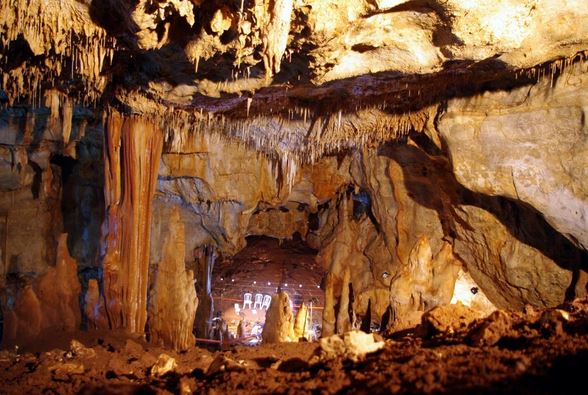An international team of European, Israeli and North American researchers has discovered a 55,000-year-old partial skull which provides clues to the migration of modern humans out of Africa to Europe.
The partial skull was found at the Manot Cave in Israel’s Western Galilee, and has been reported in this week’s issue of Nature (citation below).
A key event in our evolution was the spread of modern humans of African origin across Eurasia (Europe and Asia), replacing all other forms of hominin, between 40,000 to 60,000 years ago.
However, human fossils from this period are so scarce that linking these ancestors to all current non-African populations has been extremely difficult.

The inside of the Manot Cave where the 55,000-year-old skull was found. (Photo: Amos Frumkin / Hebrew University Cave Research Center)
The Manot Cave, a unique site, combining an active stalactite cave with depositions of Human occupation, was discovered in 2008 during construction activities that damaged its roof.
Active stalagmites (rock formations that rise from the floor of a cave) and rock falls had apparently blocked the main entrance to the cave for about 15,000 years.
The Cave Research Center, part of the Hebrew University of Jerusalem, carried out an initial survey of the cave and reported the findings of archaeological remains.
The anthropological study of the skull was led by Professor Israel Hershkovitz of Tel Aviv University, who along with archeologists Dr. Omry Barzilai of the Israel Antiquities Authority and Dr. Ofer Marder of Ben-Gurion University, also led the excavation.
The skull has a distinctive “bun-shaped occipital region at the back,” the authors wrote, resembling the skulls of modern European and African skulls. However, it differs from other anatomically modern humans from the Levant.
The Manot people could well have been closely related to the first modern humans that later colonized Europe, the researchers say.
Evidence of Neanderthals and humans
The discovery also provides evidence that both Neanderthals and humans lived in the southern Levant during the late Pleistocene, which was close to when modern humans and Neanderthals likely interbred.
The Hebrew University of Jerusalem wrote:
“This finding represents the first fossil evidence from the critical period when genetic and archaeological models predict that African modern humans successfully migrated out of Africa and colonized Eurasia.”
“It also represents the first fossil evidence that during the late Middle Paleolithic, the Levant was occupied not only by Neanderthals but also by modern humans.”
The research team suggests that the person the skull belonged to came from a population that had recently migrated out of Africa and established itself in the Levantine corridor during a period that was favorable for human migration, due to wetter and warmer climatic events over the Mediterranean and Northern Sahara.
Citation: “Levantine cranium from Manot Cave (Israel) foreshadows the first European modern humans,” Israel Hershkovitz, Ofer Marder, Avner Ayalon, Miryam Bar-Matthews, Gal Yasur, Elisabetta Boaretto, Valentina Caracuta, Bridget Alex, Amos Frumkin, Mae Goder-Goldberger, Philipp Gunz, Ralph L. Holloway, Bruce Latimer, Ron Lavi, Alan Matthews, Viviane Slon, Daniella Bar-Yosef Mayer, Francesco Berna, Guy Bar-Oz, Reuven Yeshurun, Hila May, Mark G. Hans, Gerhard W. Weber & Omry Barzilai. Nature (2015). doi:10.1038/nature14134.

